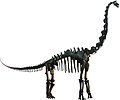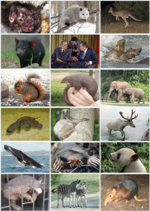 | Brachiosaurus (category Fossil taxa described in 1903) rear the posterior thoracic air sac, in the middle the anterior thoracic air sac and in front the clavicular air sac, in that order gradually diminishing... 118 KB (14,272 words) - 08:30, 1 April 2024 |
 | Russell's viper (category Taxa named by George Shaw) identity of this sensor is not certain, but the nerve endings in the supranasal sac of these snakes resemble those found in other heat-sensitive organs. Russell's... 38 KB (4,347 words) - 23:53, 26 February 2024 |
This article records new taxa of every kind of fossil archosaur that were scheduled to be described during 2023, as well as other significant discoveries... 282 KB (29,560 words) - 07:38, 10 April 2024 |
 | Bryozoa (category Taxa named by Christian Gottfried Ehrenberg) in an internal brood sac, but Gymnolaemata both external membranous sacs, skeletal chambers (ovicells) and internal brooding sacs exist. The developing... 132 KB (12,772 words) - 22:46, 15 April 2024 |
air sacs In modern birds, pulmonary air sacs are thin-walled, translucent air-filled bags connected to the lung. Together with the lung, air sacs form... 158 KB (16,339 words) - 15:38, 13 February 2024 |
 | Brown recluse spider (category Taxa named by Willis J. Gertsch) female produces several egg sacs over a period of two to three months, from May to July, with approximately fifty eggs in each sac. The eggs hatch in about... 39 KB (4,516 words) - 04:26, 31 December 2023 |
 | Lepidoptera (category Taxa named by Carl Linnaeus) other taxa, making Ditrysia. More recently, findings of new taxa, larvae and pupa have aided in detailing the relationships of primitive taxa, phylogenetic... 149 KB (16,829 words) - 20:47, 17 April 2024 |
it must meet certain quantitative criteria which are designed to classify taxa facing "a very high risk of extinction". An even higher risk is faced by... 33 KB (2,208 words) - 18:54, 31 March 2024 |
unambiguous evidence of postcranial pneumaticity in the studied taxa, and argue that an air sacs system permeating the skeletons was not present in the earliest... 273 KB (29,960 words) - 01:13, 19 April 2024 |
 | Starfish (category Taxa named by Henri Marie Ducrotay de Blainville) (morphological) features proving inadequate, and the question of whether traditional taxa are clades in doubt. The phylogeny proposed by Gale in 1987 is: The phylogeny... 104 KB (11,276 words) - 19:10, 17 April 2024 |
no fruit is set. LSI can be pre-zygotic (e.g. deterioration of the embryo sac prior to pollen tube entry, as in Narcissus triandrus) or post-zygotic (malformation... 39 KB (4,614 words) - 19:35, 4 March 2024 |
 | in a crescent-shape made of an enclosed nuchal organ. It has a canal of sacs in the coelom, lying in a continuous band. The anal and caudal shield (at... 5 KB (346 words) - 16:06, 26 October 2023 |
2021 in archosaur paleontology (section New taxa) This article records new taxa of fossil archosaurs of every kind that are scheduled described during the year 2021, as well as other significant discoveries... 283 KB (30,182 words) - 15:24, 15 April 2024 |
Physiology of dinosaurs (section Air sacs) prosauropods likely had abdominal and cervical air sacs, based on the evidence for them in sister taxa (theropods and sauropods). The study concluded that... 112 KB (13,178 words) - 03:29, 3 December 2023 |
 | Nothronychus (category Fossil taxa described in 2001) flexible. The genus Nothronychus can be distinguished from other therizinosaur taxa based on several features: a distinctly subcircular obturator process, an... 29 KB (3,311 words) - 10:04, 6 April 2024 |
has been made for the taxa, the IUCN notes that it may be appropriate to give them "the same degree of attention as threatened taxa, at least until their... 34 KB (2,335 words) - 17:07, 16 April 2024 |
 | canine, three premolars, and four molars, totaling 50 teeth. While some taxa, like the opossum, retain this original tooth count, others have reduced... 73 KB (7,557 words) - 08:32, 19 April 2024 |
 | Mammal (category Taxa named by Carl Linnaeus) further development; in many species, this takes place within a pouch-like sac, the marsupium, located in the front of the mother's abdomen. This is the... 212 KB (22,683 words) - 08:26, 19 April 2024 |
 | Camel (category Taxa named by Carl Linnaeus) dromedary camel has an organ called a dulla in his throat, a large, inflatable sac that he extrudes from his mouth when in rut to assert dominance and attract... 111 KB (10,806 words) - 19:01, 4 April 2024 |
 | from the Latin words cirritus "curly" from cirrus "curl" and pedis from pes "foot". The two words together mean "curly-footed", alluding to the animal's... 48 KB (4,637 words) - 15:32, 17 April 2024 |
 | Millipede (category Taxa named by Henri Marie Ducrotay de Blainville) Millipedes (originating from the Latin mille, "thousand", and pes, "foot") are a group of arthropods that are characterised by having two pairs of jointed... 87 KB (8,481 words) - 12:55, 28 March 2024 |
subpopulations (or stocks) are indicated. Where possible common names for taxa are given while links point to the scientific name used by the IUCN. There... 44 KB (2,737 words) - 15:05, 13 April 2024 |
 | Dilophosaurus (category Fossil taxa described in 1970) whether they differed between individuals is unknown. CT scans show that air sacs (pockets of air that provide strength for and lighten bones) were present... 119 KB (14,581 words) - 18:04, 7 April 2024 |
 | Labyrinthodontia (category Taxa named by Richard Owen) lungs. Likely air was inflated into the lungs by contractions of a throat sac against the skull floor like in modern amphibians, which may be the reason... 68 KB (7,456 words) - 19:15, 28 February 2024 |
 | Bajadasaurus (category Fossil taxa described in 2019) neural spines along the spine of dicraeosaurids would have enclosed an air sac, the so-called supravertebral diverticulum, that would have been connected... 42 KB (4,521 words) - 10:34, 27 February 2024 |
 | Siamese fighting fish (category Taxa named by Charles Tate Regan) larvae remain in the nest for the next two to three days until their yolk sacs are fully absorbed. Afterwards, the fry leave the nest and the free-swimming... 87 KB (10,385 words) - 07:18, 15 April 2024 |
 | Amargasaurus (category Fossil taxa described in 1991) enclosed an air sac, which would have been connected to the lungs as part of the respiratory system. In Dicraeosaurus, this air sac (the so-called supravertebral... 41 KB (4,520 words) - 22:26, 27 March 2024 |



